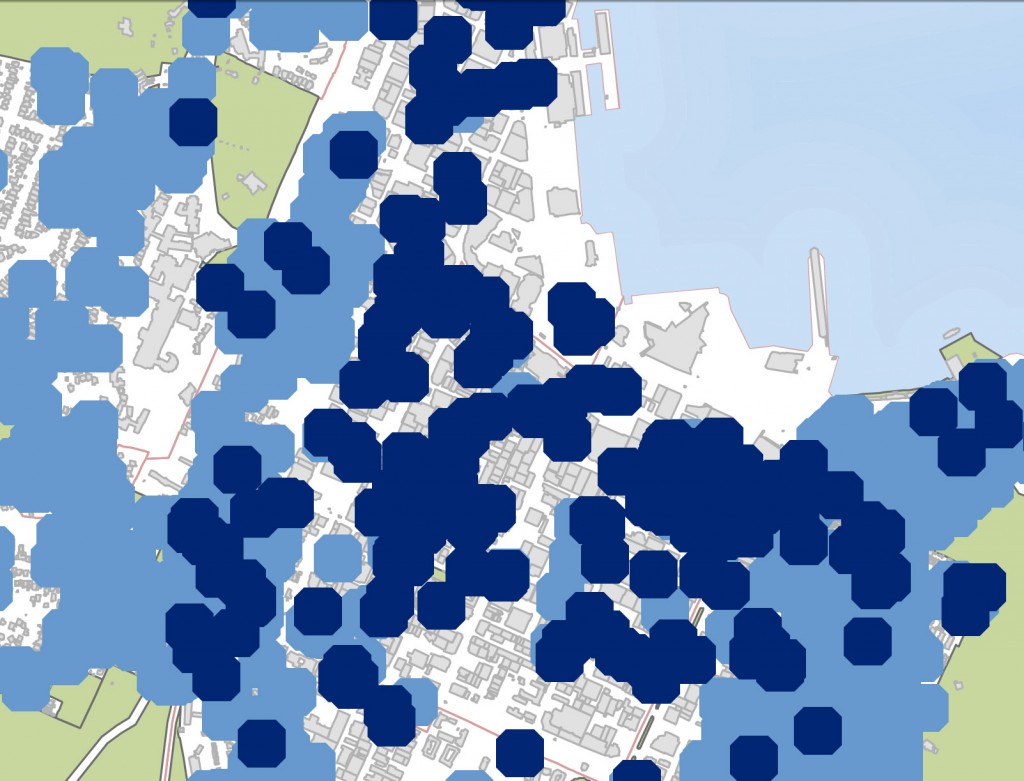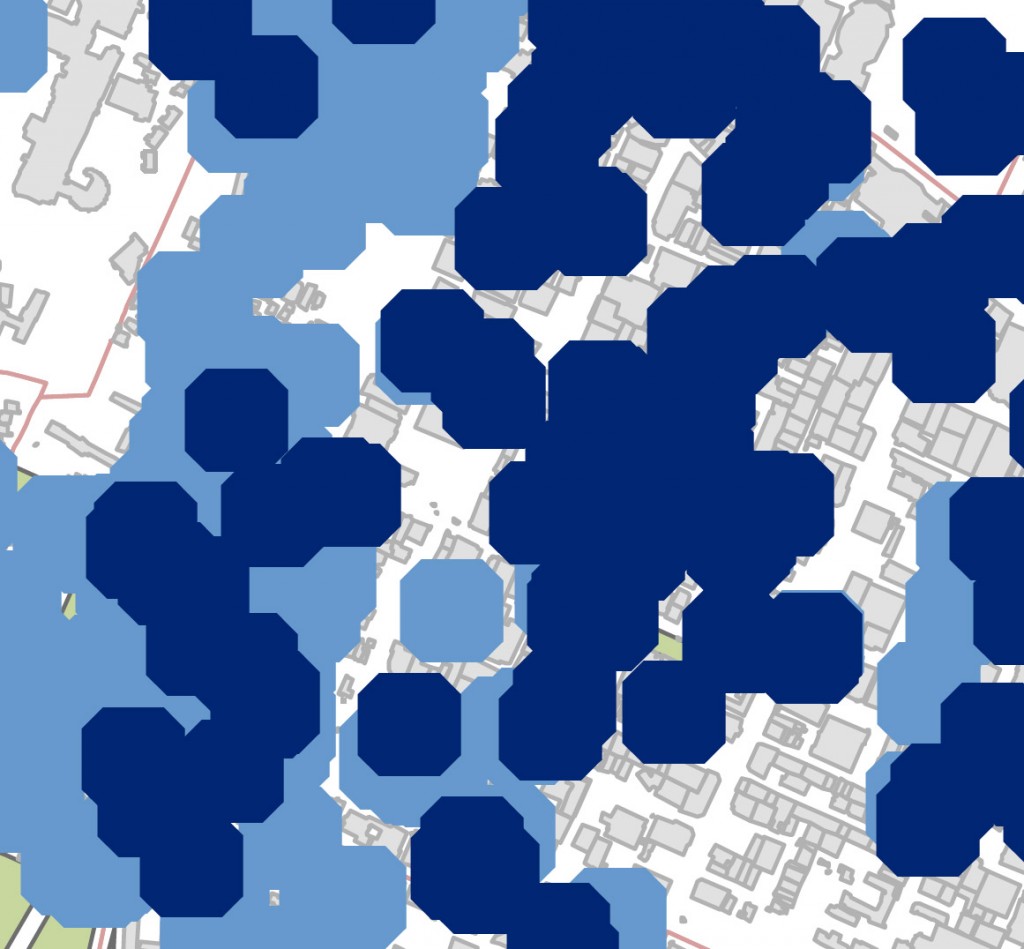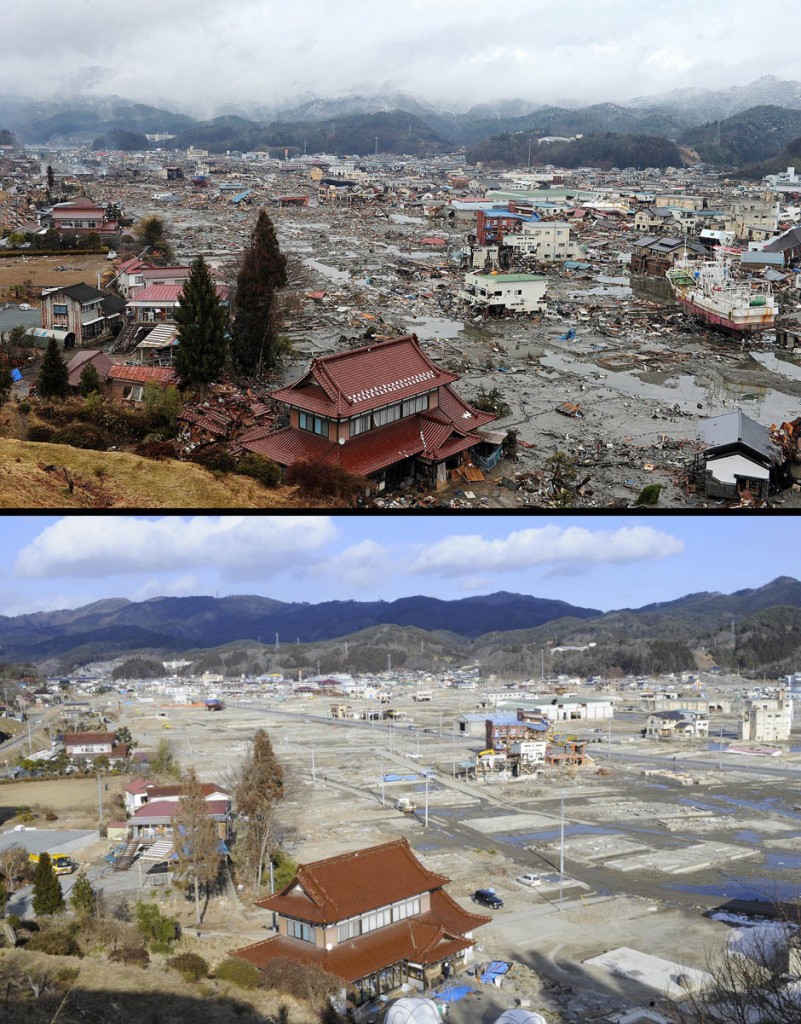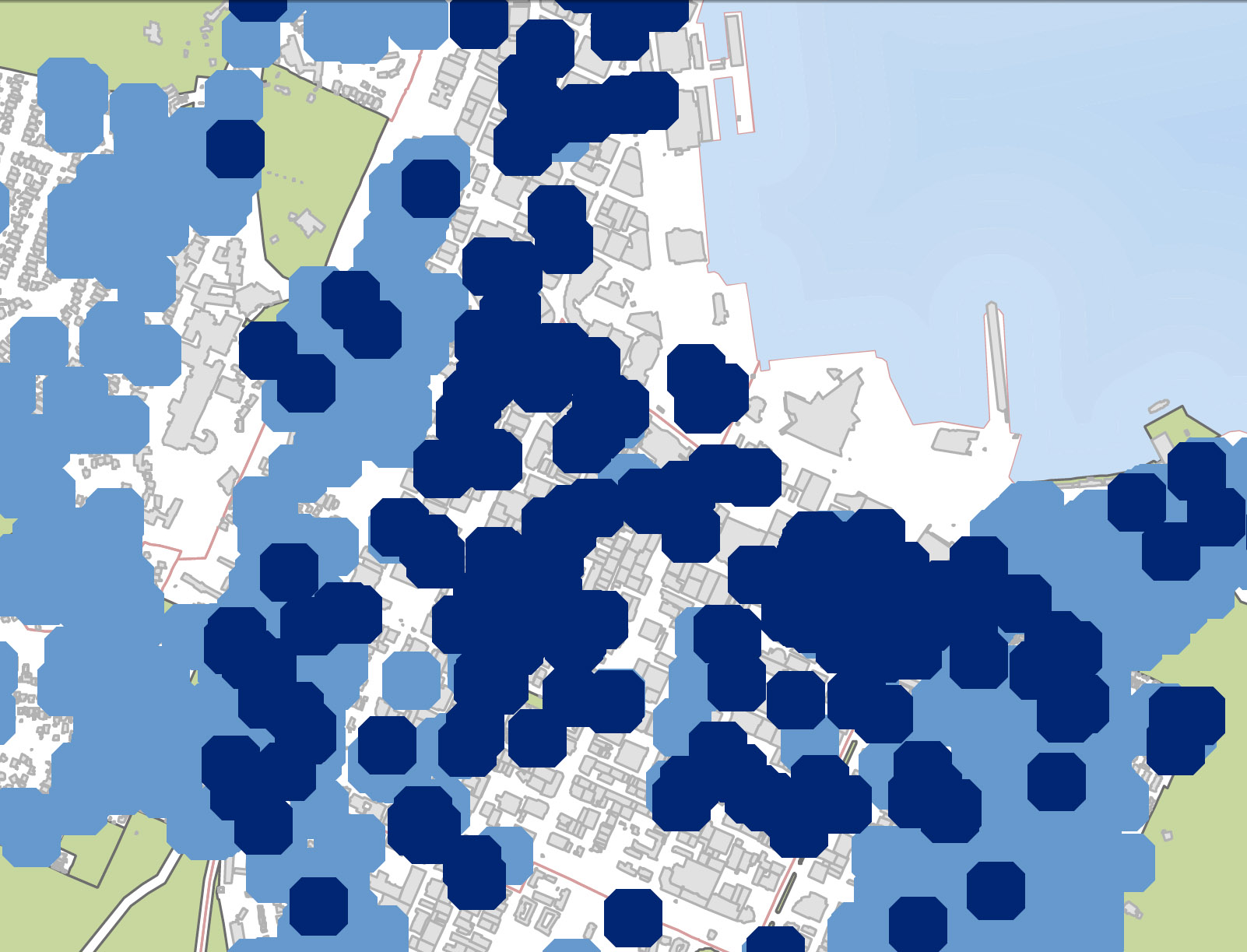Sometimes you get the feeling that the world is trying to send you a message.

This is a map of brick buildings in Wellington – unreinforced brick masonry, or URM as they are now fashionably known. These URMs are going to be a headache for all of us for the next 10-20 years… Light blue shows a URM, dark blue shows you an old (pre-1939) URM. Basically, these buildings are all absolutely fine to be in, every day, until the day of a large quake – when, all of a sudden, they are not fine at all. Ring a ring a Rosy, all fall down…
As a contrast, here is the map of heritage buildings, again with light blue showing a heritage listed building, and dark blue showing a heritage building that is also Earthquake-prone.

Basically, as you may have guessed, if you’re in a building that is dark blue on both maps, then you’ve got some work to do. If you’re working or drinking down Courtenay Place, then we have this lovely colourful pattern to deal with. Somehow, we need to make sure that we don’t lose all our interesting buildings. Dark blue is where our heritage buildings, the character of the central city, exists. This is Courtenay – she’s not a pretty sight:

This is Cuba – really, not much better:

And if you’re lucky enough to be a civil servant, here is the Lambton quarter:

Wellington urgently needs to act now to retain our cultural heritage. The Wellington City Council, interestingly enough, is at last really getting into this debate, with a very thorough report being compiled for a meeting this Thursday. I’d strongly advise you to read the report, which was published alongside the maps depicted above. Click here, and then download Report #3.
One year on, Christchurch has been reduced to rubble, the surviving buildings being mostly flat blank tilt-slab facades, boring boxes with Harvey Norman stick on facades or anonymous car yards. We too will have liquefaction, especially in the Hutt and in Miramar, but quite probably on most of Wellington’s reclaimed foreshore as well. We covered it here a year ago. Encourage your local councilor to vote to increase the spending on Earthquake-strengthening Wellington’s buildings and civil infrastructure.
The Dom Post today has said that a lack of planning is hurting Wellington. The writer, Grant Stevenson, notes some of our issues and our challenges, but comes up with some suggestions to kick start us on our way:
“Architecture alone won’t get it right; Te Papa and the Events Centre proved that. We need the wider creative community involved. Capital cities are not just about government; they can espouse cultural identity and a spirit of adventure. How would Weta tell our stories of Rutherford, Snell, Pickering, Wilkins, Sheppard, Gillies, Hillary, Batten and Pearse – all currently ignored by this capital city? Some suggestions for change:
* If we sited the new music school and rehoused the two orchestras on the waterfront giving them a shared outdoor auditorium with weather protection, student vitality would increase in the central city.* We could locate the new convention centre between Te Papa and Waitangi Park, and move the I-site to its foyer, where we could also tell New Zealand’s most profound stories to visitors.
* If we moved Te Papa’s hospitality and conference spaces into the new convention centre, they could serve both buildings, freeing up space for a new National Art Gallery within the high-spec Te Papa shell.
* We could reshape Memorial Park as an outdoor auditorium, making the national war memorial New Zealand’s most dramatic setting, especially lit at night, for performances and national days.
In 2015, Wellington will celebrate 150 years of its capital status. We need more than a set of stamps and a royal visit. We should launch a better way to be Wellington. New Zealand’s symbols of national identity are a sorry lot. Our national bird is flightless and endangered, our flag is outdated, our national day means controversy and our national colour is black. We could, however, have a national capital we take pride in. We worry about the growth and attention of other New Zealand cities but the real enemy, a lack of integrated planning, is within. We are a capital city, when will we start planning like one?”
So: when will we?
Postscript – and just as a reminder of what the Japanese have accomplished in the 11 months since their (far more devastating) earthquake and tsunami, here is a link to a series of amazing photos of Then and Now. One posted here just for you fish readers:

(Photo credit : PHILIPPE LOPEZ/AFP/Getty Images)





“* We could locate the new convention centre between Te Papa and Waitangi Park, and move the I-site to its foyer, where we could also tell New Zealand’s most profound stories to visitors.”
The UN Studio design has been earmarked for that spot, so that would be a pretty good-looking convention centre.
“We worry about the growth and attention of other New Zealand cities but the real enemy, a lack of integrated planning, is within. We are a capital city, when will we start planning like one?—
On the other hand, Canberra suffers from the opposite problem – over-planning.
Do it I say. Get started. You’ve got all of the skills and the sway to make it happen. Get it sorted. And spare a thought of my sweet, little timber, residential villa needing re-piled that might slip down the hill, if you’ve got a millisecond spare time!
Watching the Artsville program on Miles Warren yesterday, what struck me was right at the end: Warren’s gorgeous old stone home, Ohinetai, had been destroyed by the Quake. He was drawing up plans for the reconstruction almost the very next day – and now, a year later, it’s all completely rebuilt and he’s moved back in – concrete, with stone cladding, extensive timber roofing, and a floor lower than it was, if I heard right. That’s what a motivated client can do with a good architect and minimal bureaucracy.
Meanwhile, for the rest of Christchurch, the rebuild hasn’t even started yet.
[…] 20 February Wellington – we have a problem […]
My response, thoughts..
http://fholly.blogspot.co.nz/2012/02/tuhoe-terror-trouble.html
Not URM’s, they are more correctly known as Solid Masonry Un-Reinforced Failure Sites.
The blue colour is the usual giveaway
News article from DomPost :
“Human safety priority over heritage” KATIE CHAPMAN
http://www.stuff.co.nz/dominion-post/news/6469638/Human-safety-priority-over-heritage
“Heritage buildings need to be ranked for level of importance to decide which buildings are worth savings as the city looks to increase its earthquake resilience. Wellington city councillors today accepted recommendations put forward in the latest report on the city’s earthquake risk, but said human safety had to be the number one priority over heritage value. Among the recommendations adopted by the strategy and policy committee was the need to prioritise the historic value of heritage buildings to enable tough decisions to be made.
The council report into Wellington’s resilience found the city’s economy would take a $37 billion hit if it experienced an event like the Christchurch earthquake, with many core businesses and services – including the Government – likely to leave the city permanently. Among concerns highlighted in the report are the 435 buildings in Wellington with unreinforced masonry, 166 of which are heritage buildings.
Despite a two hour debate the recommendations went through unopposed today. That included the inclusion of $1.4 million in the council’s draft long-term plan to help continue work identifying at-risk buildings and to create schemes to help building owners finance strengthening work. Among the tasks that money would fund would be moves to re-evaluate heritage buildings, including prioritisation of buildings.
”What is currently required is a basis for determining which heritage buildings should be protected (regardless of cost) through to those that might require a ‘reasonable endeavours’ approach to preservation,” the report said.
Councillors today agreed maintaining the character of the city was important, but warned that it would have to take a back seat to human safety. Ray Ahipene-Mercer said it was a matter of balancing risk.
”At the end of the day would you rather be alive … or would you rather see some of these buildings still standing?”
Jo Coughlan said the council had to be prepared to make tough calls, including telling owners building they had to act. The report also covered moves to investigate ways of making repairs cheaper for owners, such as more advanced technology, talks with banks about collecting targeted rates so people could pay back special bank loans, encouraging neighbouring buildings to be strengthened together as one building, and organising bulk repairs at a discounted rate.
While much of the work would have to wait until after the Royal Commission’s findings from the Canterbury earthquake that killed 185 people, councillors said it was imperative that any steps that could be taken were done so with urgency. The city had to ensure it could recover quickly to prevent people and businesses leaving permanently, Andy Foster said.
”We can’t go slower, because if we do go slower there’s ongoing risk.”
Iona Pannett said there had to be a staged approach, where urgency was balanced against the costs. There had always been an earthquake risk in Wellington, the Christchurch event had simply heightened awareness of it, she said.
”We don’t want to create a culture of hysteria.”
Letter: Historic Places Trust is callous in its preservation stance
http://www.stuff.co.nz/dominion-post/comment/letters-to-the-editor/6457888/Letter-Historic-Places-Trust-is-callous-in-its-preservation-stance
OPINION: “Thank you for publishing Trust rejects plan for building’s fake facade (Feb 18-19). Without it, I’d have never understood how callous the Historic Places Trust is. The same edition of The Dominion Post recounted experiences of the February Christchurch earthquake. I’d like such accounts to be required reading for all members of the trust, and especially central region manager Ann Neill. Many injuries and several deaths resulting from the Christchurch quake were directly attributable to old, unsecured masonry buildings.
Similar buildings have been designated at risk in Wellington. The trust seeks to protect these same buildings, valuing them above the lives of those who live and work in them. It’s surely time to learn from the disaster. All at-risk buildings should be immediately rectified or demolished. I hope that trust members come to their senses and allow remedial work to be undertaken. Otherwise the trust must accept responsibility for any deaths in and around buildings it’s sought to stagnate in its vision of the past.”
RICHARD KELLY, Tawa
But Dick, you’re not thinking straight… “Many injuries and several deaths resulting from the Christchurch quake were directly attributable to old, unsecured masonry buildings.” Yes, but 116 deaths were attributable directly to the most modern building that collapsed. Destruction of all our heritage is not the answer either.
“All at-risk buildings should be immediately rectified or demolished.”
I’m deeply disappointed that such sad, cynical thinking is still to be found in humans alive in our city today.